Formidable and often furious, the Cape buffalo is never forgotten. These are animals that will charge down lions, tip safari vehicles, and attack when hunted.
Lion, leopard, elephant, rhino: most people know four of the big five. Cape buffalo are the missing fifth animal on the list, and they are just as impressive as all the others.
Never discount Cape buffalo. They provide stunning safari highlights, and they even hunt lions for fun (seriously, keep reading to find out!).
Here is the complete guide to Cape buffalo, the misunderstood member of the big five.
Types of Buffalo
Let’s not get confused so early on because there are buffalo all over the world, and they are not the same. Ten animals are part of the bovine family, including Mongolian yak, domestic cattle, and these different buffalo.
Cape buffalo

Cape buffalo are the biggest and baddest of its African cousins.
Can Cape buffalo be domesticated? No, people have never tamed them nor captured them for breeding programs.
Unlike domestic cattle, the African buffalo understands its own strength. It attacks, and it kills. So, there is no work in the field for them.
Where do Cape buffalo live? They are widespread across the savannahs of sub-Saharan Africa, with large populations living in East and Southern Africa.
They stick close to the water and rarely travel more than 20 kilometers from rivers and waterways. Long grass and reed beds are their favorite places to be.
Often you will see Cape buffalo covered in mud. They wallow in the mud as it keeps them cool from the African sun and prevents nasty little insects.
African forest buffalo

Also known as the Congo buffalo, this small subspecies lives in the rainforests in and around the Congo Basin. They love marshes and forest clearings. Leopards prey upon forest buffalo.
Forest buffalo are less than half the size of their savannah cousins, weighing just 250 – 320 kg (550 – 700 lbs). They have a striking reddish-brown hide, and their horns do not fuse together.
Sudanese buffalo
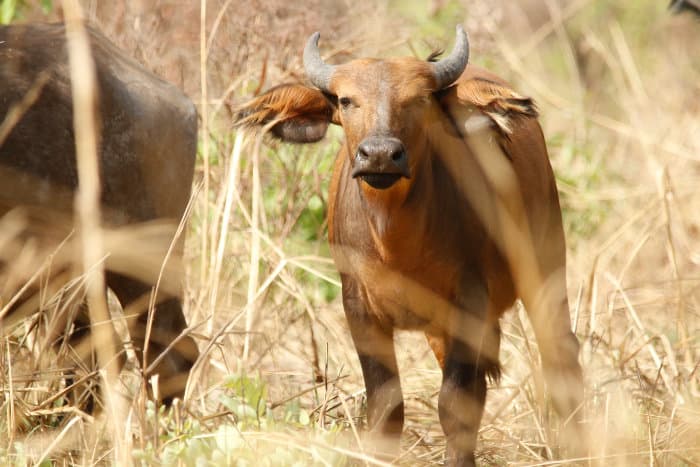
Somewhat confusingly, the Sudanese buffalo is native to West Africa and not Sudan. They roam the arid plains of countries like Ghana.
Taxonomists recognize the Sudanese buffalo as an intermediate between Cape buffalo and forest buffalo.
Some taxonomists identified other subspecies, the Nile buffalo and mountain buffalo. However, many discount these distinctions.
Water buffalo
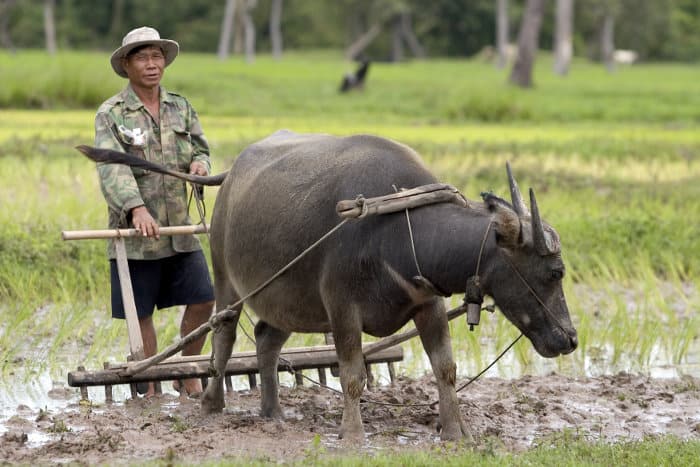
This Asian buffalo is smaller and lighter than the bison and Cape buffalo. These animals have been fully domesticated, just like Asian elephants.
Visit Thailand or Vietnam, and you can see water buffalo doing all the hard yards and plowing fields before rolling in the mud.
This domestic buffalo is now widespread across a lot of the world, including Egypt and the Caribbean. It is similar in appearance to the Cape buffalo, just half the size and with protruding horns.
Note that there are no water buffalo in sub-Saharan Africa. So when you see a buffalo on a safari, don’t be the amateur shouting out, “water buffalo!”
Wild water buffalo

Only around 3000 of these majestic Asian beasts remain, and 90% of these live in the Indian state of Assam. They are an endangered species.
These were the ancestors of domestic water buffalo and are the largest of all buffalo species. They demonstrate that through domestication and overbreeding, the water buffalo has halved in size.
Why mess with nature? It always makes things worse.
Bison

In North America, the animal commonly known as buffalo is actually a bison. Muscular with shaggy coats, bison are nomadic grazers that once dominated the American and Canadian plains. They even lived in Mexico.
There were 30 million bison just 500 years ago. By 1900, hunters went after them to near extinction, and only 1000 remained. 1000 out of 30 million!
Fortunately, their numbers have recovered somewhat, and around 31 000 wild bison now roam through America. Additionally, there are roughly 400 000 bison raised as livestock.
You can distinguish them by their large shoulder hump.
Bison have been somewhat domesticated and used in managed breeding programs. Researchers crossed them with domestic cattle to create a fertile hybrid known as the beefalo or cattalo.
These strange animals are now causing havoc, which goes to show you should never mess with nature.
Cape Buffalo Attacks: The Most Dangerous Member of the Big Five
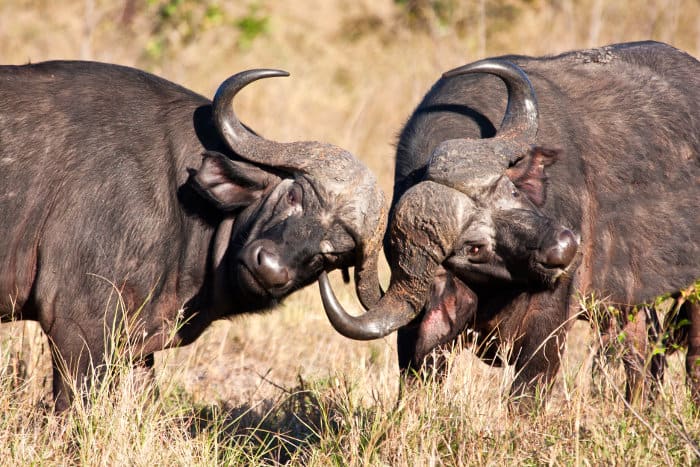
Okay, they don’t have cute fur nor an impressive roar. There is no horn nor tusks to poach. A buffalo has horns, but these aren’t proud and defiant like those of rhinos.
The big five are not the biggest five animals, nor the five most impressive safari animals. These are the brave five animals that attack hunters.
Colonialists named them the big five hunting trophies, as these were the most difficult to hunt.
Difficult is a relative term, of course – is it that difficult to shoot an animal from a distance with a team of armed trackers in support?
Some believe that Cape buffalo have killed more big game hunters than any other African animal. Go buffalo!
Estimates suggest that Cape buffalo kill over 200 people every year. However, be wary of claims that they kill more than any other African animal because people have made the same claim about hippos and crocodiles.
Mosquitoes actually kill the most.
How Much Does a Cape Buffalo Weigh?
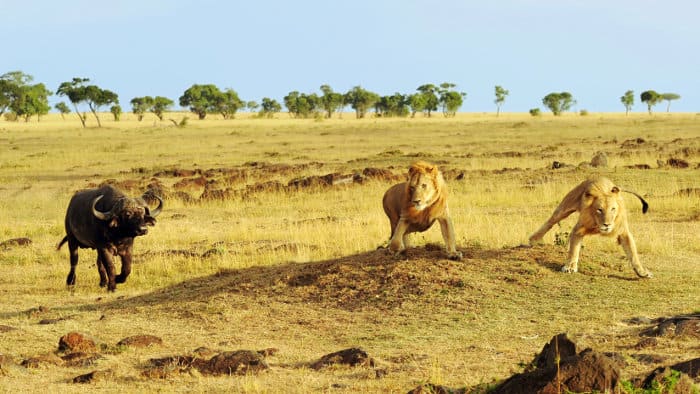
Mature Cape buffalo bulls can weigh up to 1000 kg (2200 lbs). That’s one ton of brawn and muscle not afraid to charge when threatened.
Males and females have a similar weight range, anywhere from 500 – 1000 kg, and the exact size depends on location. Studies have shown that bulls in the Serengeti and South Africa can weigh more than double those in Kenya and Botswana.
Bulls measure up to 1.7 meters at the shoulder, and they can be over three meters in length. And the one-meter Cape buffalo tail makes this a real beast. You might say that they look like cows on steroids!
Cape buffalo can hit speeds of 56 km/h (35 mph) in just a few strides. One moment they are over there. Within a few seconds, they are trampling you to death. If you want to know the complete story, have a look at this guide on a buffalo’s running speed.
Both cows and bulls develop horns. These form a solid shield that covers their skull and provides a dangerous weapon.
When the buffalo feel like it, they use this shield and go in for the Scottish kiss, or head-butt as it is more commonly known.
Bulls develop horns that measure over a meter across, with spiked tips that can gorge and kill fully grown lions (and people).
Understand Typical Cape Buffalo Behaviour
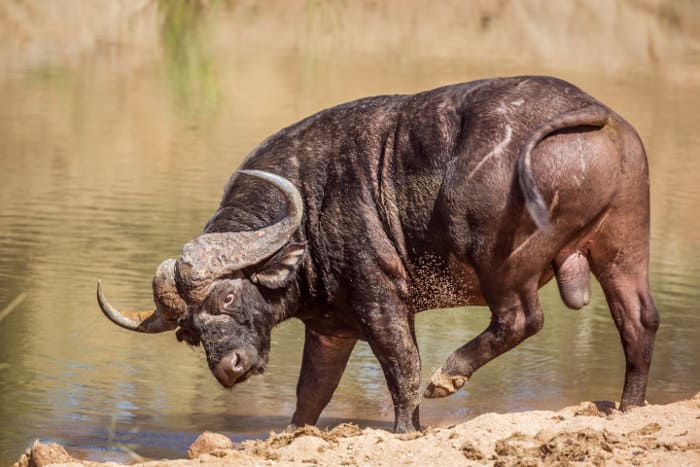
These are boisterous and unpredictable animals. Cape buffalo don’t provide any warning. They appear to be peaceful, chewing on cud and staring at the safari vehicle.
And then they charge. Buffalo tramples or gorges anything that gets in the way.
You have been warned.
Encountering big Cape buffalo herds on safari
Cape buffalo live in herds of anywhere between 10 and 200 individuals, dependent on the availability of food and water.
They travel in herds as this protects them from predators and because they are gregarious animals.
Matriarchs lead heards made up mostly of cows and their calves. One or two dominant males join these herds and take their pick of the females during mating season.
Veteran bulls graze on the outskirts of the herd. They offer protection against apex predators but don’t have the strength or desire to fight for mating rights.
It’s relatively safe to encounter these harem herds on an African safari, even on foot. They are peaceful, social, and affectionate groups of animals.
Just don’t upset them or appear as a threat, which can happen by flashing the camera or getting too close.
Young bulls leave the herd by the time they are three years old. They join up with other young bulls, forming bachelor herds marked by aggression and testosterone.
These smaller herds are notoriously belligerent. The young bulls have balls bursting with semen yet aren’t strong enough to challenge dominant males. They battle among each other and cause havoc on the African savanna.
Bachelor buffalo will charge at anything, even if they do not perceive a threat. Getting close to them is unsafe, even in a safari vehicle.
How can you tell the herds apart? Size is one feature. Or you can see a lot of swelled-up testicles and understand there is a possible threat.
African Cape buffalo are very social animals
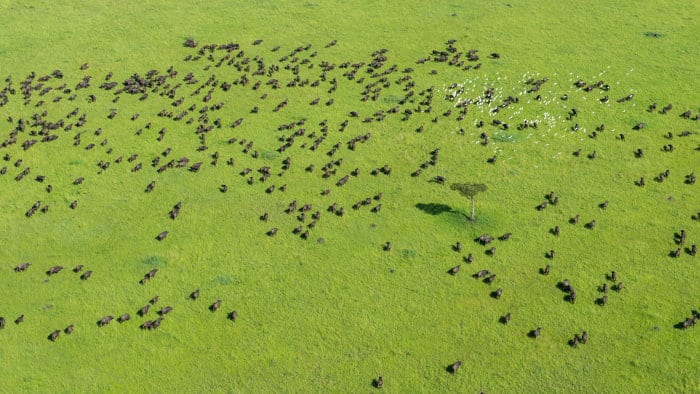
Despite their somewhat antagonistic reputation, Cape buffalo are convivial characters who continually communicate with each other.
They make a beautiful range of sounds, although most safari goers only hear grunt grunt, mumble mumble.
Communication is via a complex mix of gargles and grunts, with meaning conveyed by volume and pitch. Mothers gargle to their calves and warn the herd of danger.
Most buffalo sounds are inaudible to human ears. For more information, check out this article on all the different Cape buffalo sounds.
These animals are friendly with each other. Mutual grooming is part of their everyday routine.
They create giant cuddle puddles by resting chins on each other’s backs. Affectionate nuzzling and ear chewing aren’t foreplay but further signs of affection among the herd.
The entire herd cares for sick and wounded individuals. Animals are not left behind; even blind buffalo continue to get support and protection from the herd. This is a species that really has the all-for-one and one for all attitude!
All the females and calves form strong bonds, rather than just a mother and her own calf.
These females are incredibly cooperative as each member of the herd will participate in babysitting duties and respond to a youngster’s distress call.
Attack is the best form of defense
A healthy one-ton buffalo is no match for any predator. However, the young and sick are a great meal for carnivores, especially lions and spotted hyenas.
Cape buffalo herds encircle their young, forming a steely wall of defense. Lions harry the herd, seeking to panic and separate a calf.
It’s a dangerous hunting tactic because buffalo love to charge and use attack as a form of defense. Some lionesses must incur their wrath so others can lay an ambush.
Charging at a predator to protect your young makes sense, especially when you have the size and strength of a Cape buffalo.
These animals are bigger than their predators and need to show it. However, Cape buffalos also maul lions for fun.
Some say that an African buffalo never forgets a hunter. They carry out revenge attacks on their predators, including hunters that carry guns.
There are many stories of buffalo herds attacking hunting camps when they least suspect it. The hunters think they are looking for a buffalo to shoot.
Then bam! The buffalo attacks hunters and tramples over them.
Mature buffalo will attack a lion’s pride and trample their cubs out of revenge and spite. Taking out young lions before they grow powerful is also a good long-term survival strategy.
Cape buffalo regularly turn the tables. If they sense any danger, they will attack. Usually, there is no warning. Occasionally, a herd will creep up and lay an ambush, before tramping and gorging their predators to death.
Veteran bulls are even known to chase and attack lions purely for sport. Imagine that? What are you doing today? Grunt grunt, I fancy killing a lion for a laugh, mumble mumble grunt.
Domestic cow bulls can be aggressive, but to take the comparison further, think of Spanish bullfighting or American rodeo.
Often, aggravated bulls will lose their temper and go berserk. The frenzied bull runs wildly, which then makes it easy to tame in the name of sport.
Cape buffalo wouldn’t stand for such a thing. They are smart animals and would attack long before they even reach the ring.
Reproduction and breeding
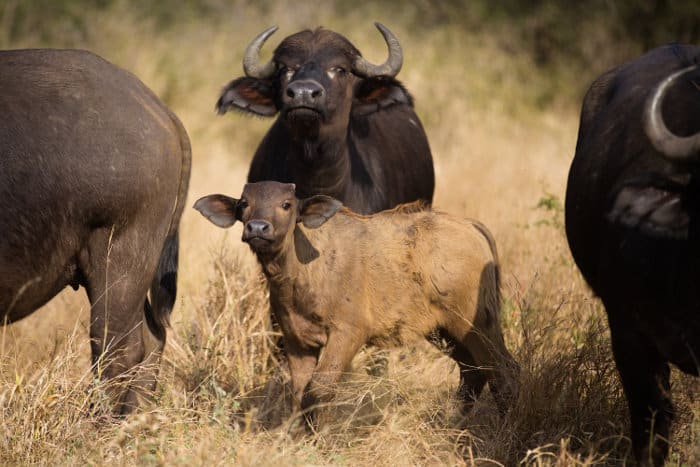
As with other matriarchal species, Cape buffalo reproduction is a strictly controlled process. There is no fooling around or jumping on for a quickie.
Birthing and mating are synchronized to occur at the same time of year, a one-month window when the grass is lushest, and water is most readily available. Gestation is 11 months.
Studs spend 11 months solidifying their dominant position. Then they have one month to impregnate as many cows as possible. Most cows have a two-year cycle, so they either give birth or breed each year.
It is rare that more than two studs get to breed with the herd. And it’s unusual for a bull to enjoy more than one year as a dominant stud. By the next mating season, they will have turned to veteran status.
Other bulls must build their strength, and some never get the opportunity to mate.
Cape Buffalo Population in Africa
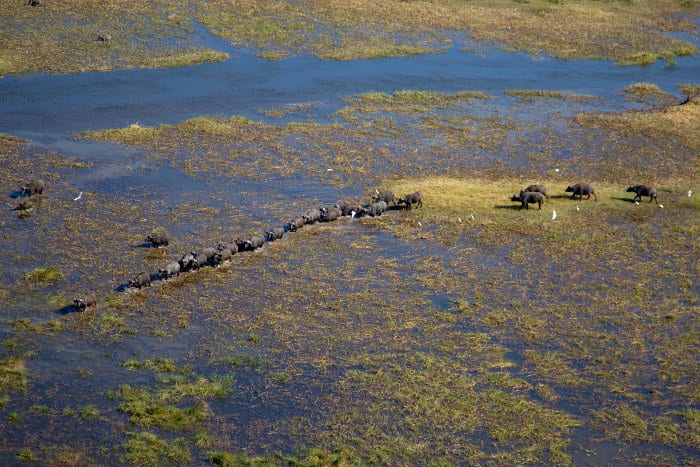
Wondering, “how many Cape buffalo are left in the world?” The population of this large and abundant herbivore is decreasing.
A 1999 IUCN study put the total population at 830 000 and suggested this was a conservative estimate. The AWF still estimates that 900 000 Cape buffalo remain.
In 2019 the IUCN released a more damning report. The entire population has decreased to just 400 000 mature individuals, and the Cape buffalo is now rated as near threatened on the red list.
Why Are Cape Buffalo Endangered?
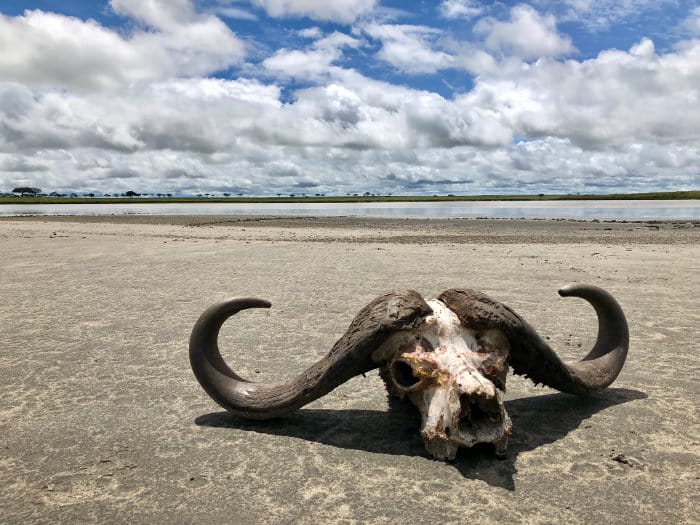
These majestic beasts have suffered before. In the late 19th century, a rinderpest epidemic swept across Africa and wiped out 95% of the buffalo population. But these hardy animals recovered.
Are African buffalo endangered? The conservation status shows that they are a “least-concern” species.
Unfortunately, not everybody likes buffalo, and now the threat to survival comes from humans. Hunting and poaching are bad enough, but the real threat comes when Cape buffalo come into contact with farms and other livestock.
They smash down fences and graze on crops. And why should they not?
After all, Cape buffalo grazed on the land long before there were farms, fences, and cultivated crops. So buffalo outside national parks are commonly shot by farmers and villagers.
Habitat fragmentation exacerbates the problem. Broken wildlife corridors increase the likelihood of Cape buffalo coming into contact with farms and villages. They are also more likely to encounter hunters.
More Cape Buffalo Facts (Infographic)
Seeing Huge Cape Buffalo Herds on Safari
Fortunately, Cape buffalo do remain the easiest of the big five to see on a safari. You can find them in almost every safari park and reserve, from enormous national parks to small fenced preserves.
Let’s hope that they don’t go the same way as the rhinos. It wasn’t that long ago that over 400 000 rhinos roamed across Africa. Now there are only 20 000.
The African elephant population has dropped from 5 million to 400 000 in just one century.
It’s time to protect and preserve. And that can start by going on a safari and seeing these epic beasts in their natural habitat.
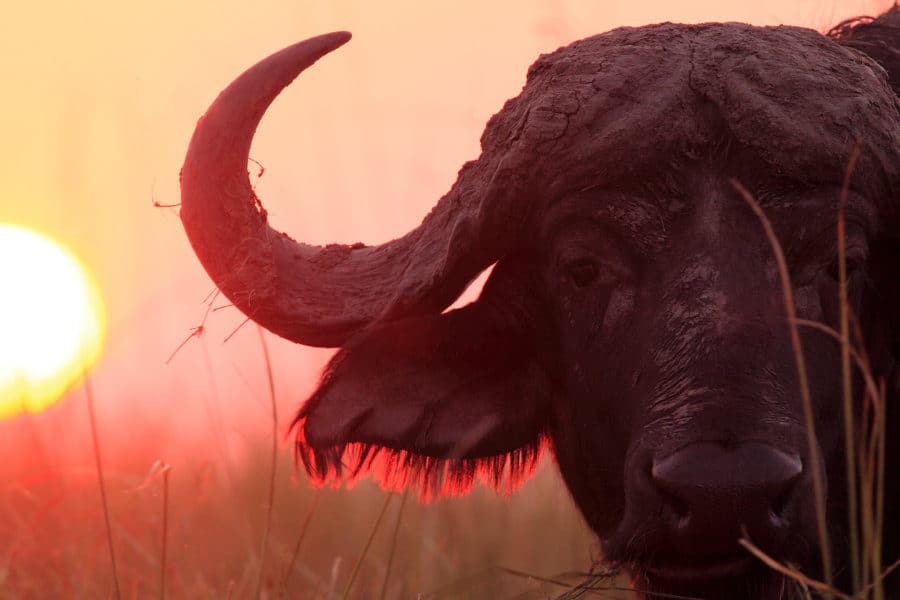

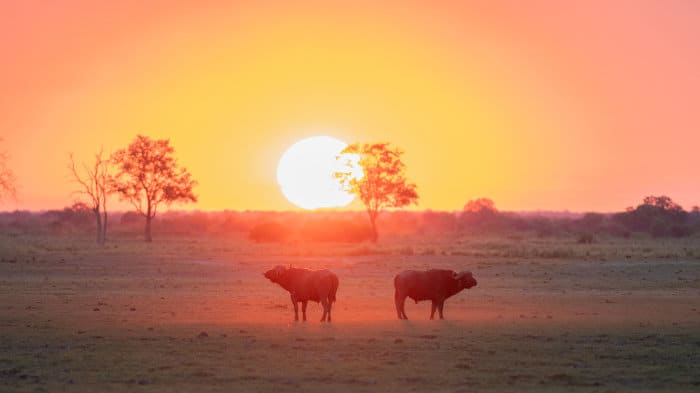
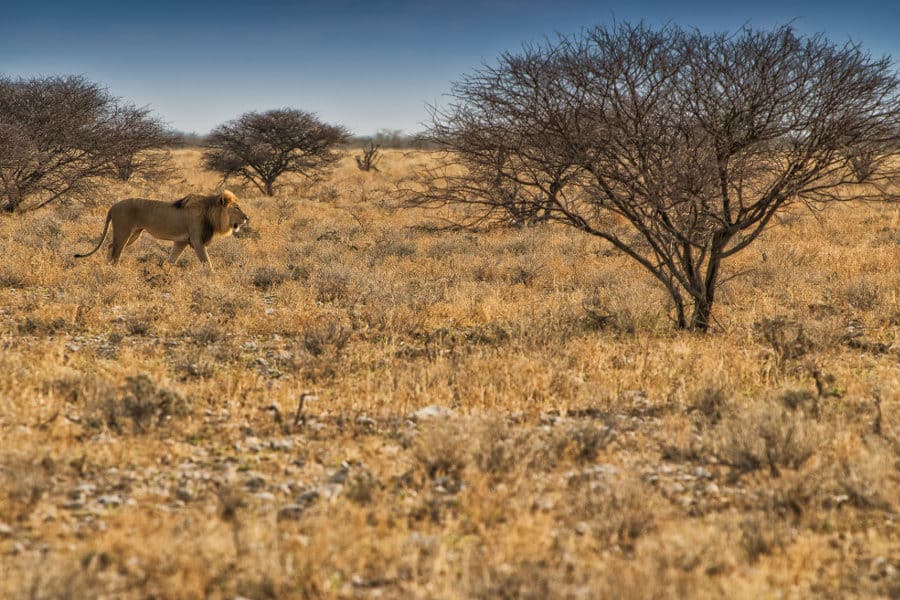
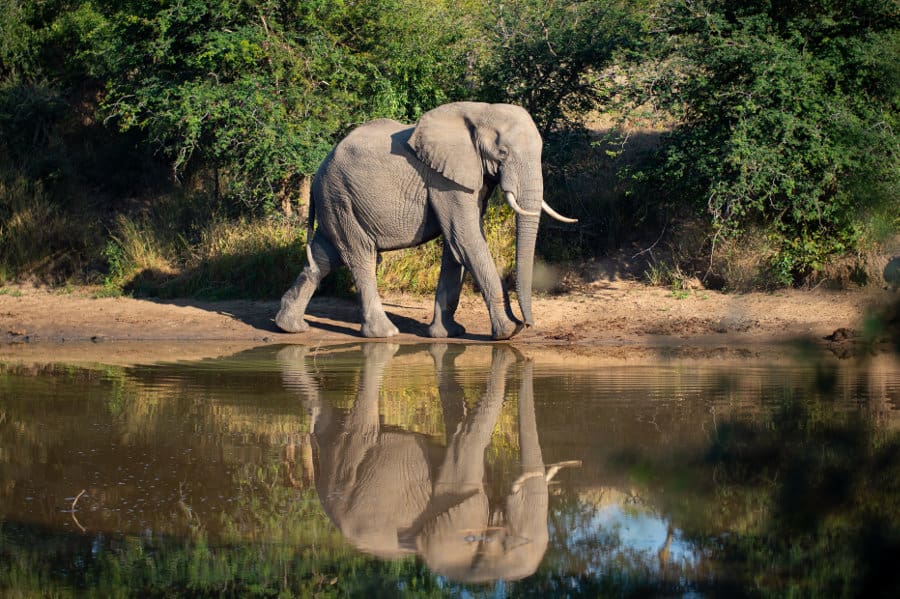
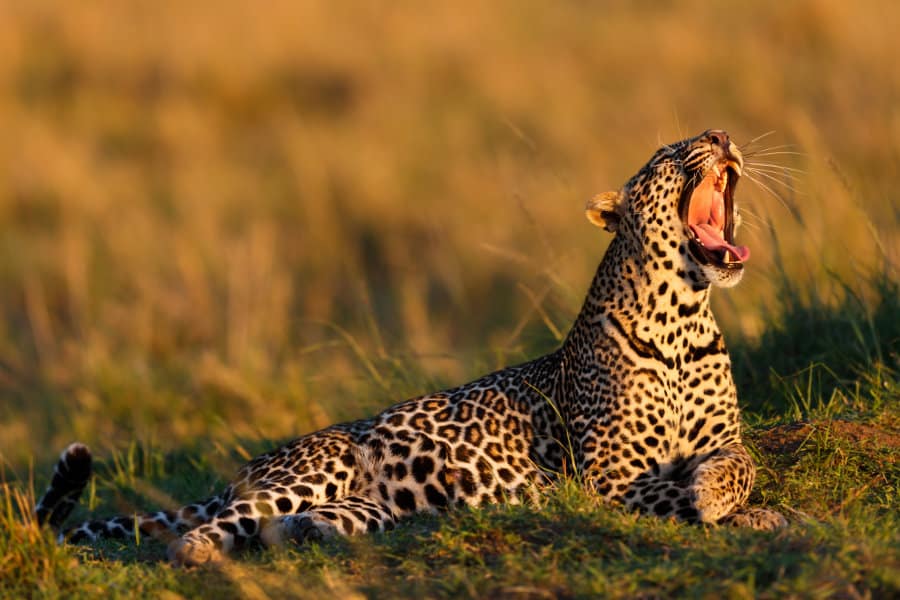
Thank you for this informative article. I really enjoyed reading it.
Glad it helped, Allen. 🙂 Have a splendid weekend!